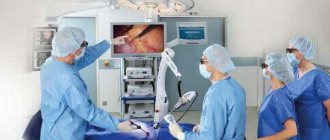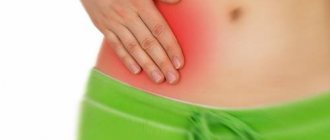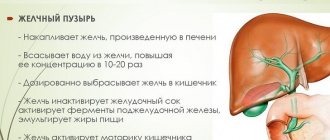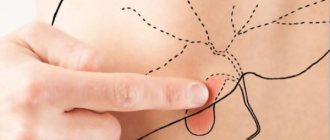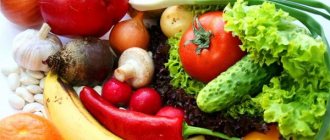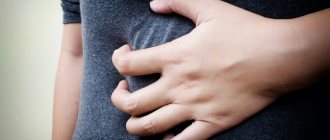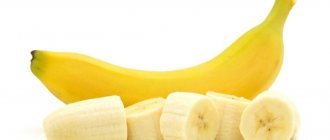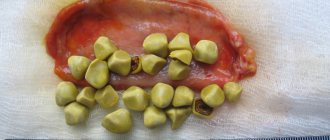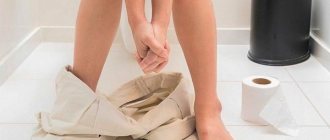Reasons for gallbladder removal
The gallbladder is an organ in which minerals and fluid are absorbed from bile. As a rule, inflammation occurs due to a violation of the outflow of bile. In 94-96% of patients hospitalized in the surgical department, cholelithiasis is detected. Treatment begins with medications. If there is no effect, surgery is performed to remove the gallbladder (cholecystectomy). Main reasons:
- Cholelithiasis.
- Acute or chronic inflammation of the gallbladder.
- Neoplasms.
- Traumatic injury.
- Purulent organ damage.
Human gallbladder
The gallbladder can be removed laparoscopically and openly. In the first case, instruments are introduced into the abdominal cavity through micro incisions. The operation is minimally invasive, reducing the number of complications and days of hospital treatment. Recovery takes less time. The scars are practically invisible. The cosmetic effect is especially important, since the pathology most often occurs in women. In many clinics around the world, 95-97% of patients are operated on laparoscopically.
An open operation to remove the gallbladder with an incision along the anterior abdominal wall is performed when diseases that were not recognized before cholecystectomy are detected (malignant or benign tumors in the gallbladder, stomach or colon) or complications (massive bleeding that cannot be stopped laparoscopically, damage to extrahepatic gallbladders). ducts).
What measures can you take?
The patient spends several days after removal of the gallbladder in the hospital under the supervision of medical staff. During the postoperative period, the person strictly follows a diet designed to prevent excessive gas formation, constipation or diarrhea. If necessary, the patient receives medications that inhibit peristalsis and replenish losses of fluid, vitamins, and minerals.
As a rule, the main problems begin after discharge from the hospital. They arise as a result of gross nutritional disorders. The disorder is not long in coming: debilitating diarrhea appears, and with it loss of body weight, fluid and poor health. Rapid cleansing of the intestines during diarrhea provokes unabating hunger, due to which the patient begins to eat more. A vicious circle arises - the so-called hologenic diarrhea, which can provoke very sad consequences.
To prevent hologenic diarrhea due to gallbladder removal, there is no need to reinvent the wheel. Often it is enough to adhere to dietary recommendations and limit physical activity. In particularly difficult cases, they resort to medications to combat diarrhea, which are prescribed only by a specialist.
Medications to combat loose stools
If diarrhea after removal of the gallbladder does not stop for a long time, and its intensity only increases, this is an alarming symptom. It should be a reason to seek emergency medical help. Severe hologenic diarrhea after removal of the gallbladder is stopped purely by medication. As a rule, a drug such as Regidron is used to restore electrolyte balance.
Additionally, medications that counteract dysbiosis are prescribed. To remove toxic breakdown products, absorbents are also prescribed. Smecta is often recommended for severe diarrhea after organ removal.
Diarrhea after cholecystectomy entails a sharp decrease in the efficiency of functioning of all body systems, therefore, during the recovery period, it is advisable to combine medication with vitamin therapy. But prescribing them independently is unacceptable, since vitamins can provoke allergies.
Traditional methods of combating diarrhea
Long-term hologenic syndrome requires medical correction, but in the first days you can try to correct the situation yourself. Sometimes loose stools after removal of the gallbladder are perfectly eliminated by folk remedies. Among them, the following are especially popular:
- Activated carbon;
- pomegranate peels;
- vodka with salt;
- rice broth;
- Oak bark.
Oak bark will give almost instant results. To prepare the remedy, pour 250 ml of boiling water into a tablespoon of dried and crushed bark. This infusion is kept for about an hour, after which it is filtered and drunk. It is best to take this remedy in consultation with your doctor. If after 2 days the patient’s condition has not improved and the diarrhea does not disappear after removal of the gallbladder, then it is worth resorting to other means.
Activated carbon will also help eliminate the disorder. Its dosage for such a problem should be checked with a doctor. In addition, in parallel with taking such a remedy, you need to drink sufficient volumes of water in order to protect yourself from general dehydration of the body.
To stop diarrhea after surgery, you can also resort to rice water. To prepare this remedy, add 1.5 tbsp to 500 ml of boiling water. l. rice, after which the mixture is simmered over low heat for about 40 minutes. The cooled broth is filtered and drunk several times a day in small portions. As a rule, such treatment gives quick results.
Recovery after surgery
The postoperative period often passes without complications, but half of the patients develop digestive system disorders. Their entire set, including hologenic diarrhea, is combined into the concept of postcholecystectomy syndrome (PCES). The distinguished variants of PCES are:
- Dyspeptic (a feeling of bitterness in the mouth, especially on an empty stomach, nausea, diarrhea or constipation).
- Painful (constant pain in the right hypochondrium of varying intensity).
- Jaundice (periodic jaundice of the skin and sclera, combined with or without pain in the right hypochondrium).
- Clinically asymptomatic (the patient has no complaints, but according to ultrasound and biochemical blood tests, pathological changes are determined).
Postcholecystectomy syndrome
The results of a study by the Central Research Institute of Gastroenterology (Moscow) showed that the first option is the most common.
Normally, bile is produced continuously and accumulates. Excretion in portions depending on the volume of food depends on the gallbladder. The human body produces approximately 1-1.8 liters of bile, which, when concentrated, enters the intestines after meals to break down and absorb fats and activate pancreatic enzymes. Bile is associated with the breakdown of proteins and carbohydrates, the absorption of fat-soluble vitamins, and inorganic salts. Under the influence of bile, the acid and enzymes of gastric juice are inactivated.
After surgical removal of the organ, the mechanisms that regulate the release of hepatic bile into the lumen of the duodenum disappear. Regardless of whether there is food in the intestines or not, intake occurs constantly. Bile acids act as a laxative, increase fluid secretion, and stimulate peristalsis. The small intestine contracts more often, and the passage of food through the intestinal tube accelerates. The consistency of stool and color changes. The stool is homogeneous green-yellow or with greens and admixtures of undigested food particles due to bile contents.
There are several ways to help the body digest food in new conditions:
- Reduce the amount of food.
- Eat more frequently during the day.
- Change your diet (reduce the amount of fats and foods that affect peristalsis).
The severity of diarrhea is determined by the concentration of bile coming from the liver, a feature of the autonomic nervous system and intestines.
Drug treatment
As a rule, diarrhea and other unpleasant symptoms appear when a patient who has had their gallbladder removed returns home. This happens because the patient violates nutritional rules.
After cholecystectomy, the patient must take the medications prescribed by the doctor
According to medical statistics, overweight people more often need surgery. They get tired of the monotonous menu and return to their previous diet, believing that the danger is now behind them. However, this opinion is erroneous. After a few days, the patient develops diarrhea, loses weight and fluid, and his condition worsens.
Patients who experience cholagenic diarrhea often have questions about how to treat it. Therapy consists of taking the following medications:
Drugs after gallbladder removal
- Enterosorbents are a group of medicines that cleanse the body of harmful substances and normalize the functionality of the intestines. For this purpose, the following medications are used: Smecta, activated or white carbon, Lactofiltrum, Filtrum.
- Antibacterial agents are prescribed when pathogens are detected in the intestines or the presence of an inflammatory process.
- Preparations containing lactobacilli, probiotics, prebiotics (nutrient medium for beneficial microorganisms). To eliminate diarrhea and restore normal microflora, use Normabakt, Linex, Bifiform.
- Medicines containing bile acids and bile are used for additional therapy (Cholenzim, Lyobil, Allochol).
To speed up the production of their own enzymes, Hepatosan, Cyclovalon, Ursosan, Enterosan are used. To slow down intestinal motility, Loperamide is prescribed.
Due to the loss of large amounts of water and salts due to diarrhea, it is recommended to take Regidron for 2 to 3 days. The glucose-salt preparation retains fluid in the body.
Treatment of diarrhea should be comprehensive; along with the medications described above, multivitamin complexes and immunomodulatory agents should be taken. This is due to the fact that during diarrhea the body loses a lot of useful substances.
Conservative treatment lasts from 2 weeks or more. The duration of the therapeutic course is determined by the doctor for each patient individually.
For chologenic diarrhea, it is prohibited to take drugs that increase the secretion of liver secretions and facilitate its entry into the intestines. To restore liver functionality, hepatoprotective drugs are prescribed.
Diarrhea after cholecystectomy
Hologenic diarrhea is diarrhea three or more times a day after cholecystectomy. Chronic bowel dysfunction lasts more than four weeks. In most patients, bowel movements return to normal, but this takes time. An unpleasant symptom slows down the return to the original level of activity.
Frequent loose stools are an uncomfortable condition, but not dangerous to health. With massive fluid loss, dehydration and electrolyte imbalance may occur. If “symptoms of anxiety” appear, you need to consult a surgeon and therapist:
- Blood in the stool.
- Fever.
- Abdominal pain.
- Weight loss.
- Constant thirst.
- Cramps of the calf muscles.
- Diarrhea for more than four weeks.
Several episodes of diarrhea after surgery do not require additional tests or examinations. If other symptoms appear, diagnosis is carried out according to indications.
Traditional methods of treating diarrhea and diarrhea
Traditional methods of treating symptoms of diarrhea and diarrhea have long been used. For this purpose, decoctions of oak bark, wormwood, cherry, and St. John's wort were used. Bird cherry fruits, blueberries, apples, cones, and nuts were also used. These methods are used only as symptomatic treatments before seeing a doctor. After diagnosis and consultation with a doctor, you should at least temporarily abandon traditional methods of treatment and adhere to the prescribed treatment, following all prescribed recommendations. This is the only way you can overcome the complications that arise after cholecystectomy.
Treatment of hologenic diarrhea
The main goals of therapy are to restore the normal biochemical composition of bile, the function of the biliary tract and minimize the continuous effect of bile acids on the small intestine. In most cases, following the recommended regimen and diet leads to recovery. The need to prescribe medications is determined by the doctor in each specific case.
Postoperative regimen
After laparoscopic surgery, on the first or second day you are allowed to walk for 30-40 minutes daily, do breathing exercises and exercise therapy. Lifting weights more than 5 kg in the first 7-10 days is contraindicated. After 4-6 months, the range of physical activity expands, running and working out the abdominal muscles are added. The recovery time is determined by the presence or absence of complications, the initial level of physical fitness, and concomitant pathology.
Features of nutrition with a removed gallbladder
To prevent bile from accumulating in the ducts, food should be eaten frequently and in small portions. The optimal number of meals is 5-7 per day. The volume of the main portion is 200-250 ml. Be sure to have 2-4 snacks. Fats are limited to 60-70g per day.
For hologenic diarrhea in the early postoperative period, American therapists recommend the “BRATTY” diet. It includes bananas, rice, apples (preferably baked), weak tea, dry day-old bread and biscuits, and natural yogurt. It is important to drink enough fluids to prevent the opposite problem - constipation.
Following a number of recommendations will help improve the quality of life after surgery:
- Reduce the amount of fatty and fried foods. Steam, stew or boil food. There is no need to completely eliminate fats from your diet. In one meal, 3 grams of fat are digested. Larger amounts cause dysmotility and bloating.
- Increase fiber intake over 2-4 weeks. Include cereal porridges, whole grain flour products in your diet, add butter and vegetable oil. A sharp increase in fiber leads to gas formation.
- For protein products, low-fat fish (hake, pollock) and lean meat (chicken, quail, rabbit, beef) 1-2 times a week are recommended. Reduced-fat dairy products (cottage cheese, kefir, yogurt) are offered for snacks and dinner.
- The diet should include vegetables, fresh stewed and baked. Fermented and pickled foods are not recommended to prevent bloating.
- Coffee worsens the symptoms of diarrhea, so it is better to avoid it. Replace sweets with non-sour fruits and honey.
Drug correction of diarrhea
Diarrhea syndrome should be treated depending on the severity and accompanying complaints. To prevent electrolyte disturbances in the acute period, rehydration solutions are prescribed (Regidron, Ionica, Bio Gaia ORS). Probiotics (Enterozermina, Enterol, Linex) help normalize the intestinal microflora. To treat painful spasms, antispasmodics (Mebeverine hydrochloride) and choleretic drugs are prescribed. Herbal preparations containing silymarin (Gepabene, Essentiale, Karsil, Darsil) normalize liver function.
If signs of inflammation are detected, antibiotics are required (Erythromycin, Clarithromycin, Ciprofloxacin). To weaken motor skills, loperamide (Imodium, Lopedium) is used. Enzyme deficiency can cause diarrhea, flatulence, and heaviness in the stomach. Creon (Pangrol, Panzinorm, Ermital) helps replenish enzyme deficiency and facilitate the digestion of food. With diarrhea, the absorption of nutrients is limited, so vitamin and mineral complexes containing omega 3 fatty acids, magnesium, and vitamins B and C are prescribed.
Without lifelong adherence to a diet and regimen, drug therapy is ineffective.
Irritation from diarrhea
Hologenic diarrhea causes damage to the skin of the anus from bile and irritating acids. A few rules will help alleviate the painful condition.
- After bowel movements, do not rub, but soak. Use baby wipes instead of toilet paper.
- Apply a thin layer of baby protective cream against diaper dermatitis to the anus. The barrier will protect irritated skin from the action of bile acids.
- Avoid hot spices and herbs. Stimulating bile secretion will lead to more irritation.
- Keep a food diary. This way you can mark dishes that provoke an unpleasant symptom.
What to do if you have diarrhea
If diarrhea does occur to you after surgery, you need to take immediate action. It does not matter what caused the cholecystectomy. If you do not treat PCES, which causes diarrhea, you can get more serious complications, including an attack of acute pancreatitis. Therapy for stool disorder after removal of the gallbladder is based on 3 pillars: taking the necessary medications (as recommended by a doctor), proper nutrition, a healthy lifestyle (exclude smoking and drinking alcohol) And the right psychological attitude is also very important.
Detoxifying drugs
Drug treatment tactics depend on the severity of diarrhea. If loose stools occur every day for 2-3 days, we can talk about dehydration. Sometimes it doesn't show up right away, but there are major changes happening inside our bodies. With diarrhea, not only fluid is lost, but also potassium, vitamins, and beneficial microelements. Special solutions, for example, Regidron, help replenish the balance.
Detoxifying drugs will help cleanse the intestines:
- Smecta,
- White coal,
- Polysorb,
- Enterosgel.
What enzymes can you take?
At first, you need to help the gastrointestinal tract digest food. For this, there are special preparations containing enzymes: Creon, Panzinorm, Microzim, etc. People with problematic pancreas should definitely take them.
Note! Some patients get hooked on enzymes, because with them it’s easier not to follow a diet or limit yourself. Fermented medications should only be taken when necessary. Constant use leads to “lazy” pancreas syndrome, when the organ refuses to digest food without enzymes and work independently.
Choleretic drugs
If diarrhea is associated with improper outflow of bile, a violation of its production, doctors prescribe taking choleretic drugs - Cholesal, Lyobil. Gastroenterologists advise taking a course of Ursofalk or Ursosan for the first time after surgery. The drugs normalize the flow of bile, improve its quality, and allow the gastrointestinal tract to quickly adapt to new conditions.
Antispasmodics for pain
If there is pain in addition to diarrhea, use antispasmodics (Buscopan, Duspatalin, No-shpa). It is advisable to drink them half an hour before meals. They normalize the flow of bile, the function of the ducts, and the sphincter of Oddi. Treatment can include vitamin complexes containing omega-3, vitamins C, B, magnesium, and potassium.
Types of cholecystectomy
Removal of an organ can be carried out in two ways: using laparoscopy or during major abdominal surgery. As a rule, doctors try to use a less traumatic operation (laparoscopy), but there are situations when its use is unacceptable.
Cavitary
This cholecystectomy is performed in the event of the development of peritonitis, acute inflammation of the walls of the organ, or severe damage to the ducts. It is performed under general anesthesia, through a long incision in the middle part of the peritoneum, or a lateral incision on the right hypochondrium.
During the operation, the doctor finds and ligates all blood vessels, arteries and ducts leading to the organ, after which he removes and removes the bladder. If necessary, drainage is installed and the incision is sutured. Such an intervention does not go unnoticed, causing frequent postoperative complications.
Laparoscopy
This method is considered the safest, painless, and does not require long-term rehabilitation. The operation is performed using small punctures in the anterior part of the peritoneum, into which all the necessary instruments are inserted. A sufficient amount of carbon dioxide is injected into one of the holes to improve visibility and improve access to the organ.
Using special manipulators, the doctor pinches off the gallbladder and removes it through one of the punctures. As a rule, the entire procedure takes about an hour, and if there are stones in the gallbladder, they must first be crushed. After removing the organ, temporary drainage is necessary to drain the fluid.
Watch a video about laparoscopy:
Causes of gallstone disease
Single and multiple stones in the gall bladder can appear for several reasons:
- Advanced age of a person. The older he is, the greater the likelihood of stone formation, and this occurs more often in women.
- Formations in the bile ducts and bladder can be a hereditary disease. That is, it is not the stones themselves that are passed on from generation to generation, but the predisposition to their appearance
- Violation of proper nutrition. The presence of excess fatty foods and proteins in the human diet.
- The reverse situation of overeating is fasting. Passion for mono-diets and monotonous nutrition, for example, vegetarianism.
- Alcoholism.
- Sedentary lifestyle associated with work.
- Disruption of the small intestine - all kinds of colitis, often accompanied by abnormal bowel movements.
- Diabetes mellitus and other systemic diseases.
Symptoms of cholecystitis and cholelithiasis
Inflammation of the gallbladder and blockage of its ducts with stones have common symptoms; if you feel them, you should immediately consult a doctor.
First of all, it is pain. It is localized in the right hypochondrium, but sometimes it is reflected under the right collarbone or in the shoulder. The pain worsens in the evening or in the morning. It can be sharp, aching, tugging. Pain may be aggravated by changes in body position, before or after eating
The pain causes constant tension in the abdominal muscles, which naturally increases the patient’s discomfort. Belching, nausea, vomiting, and bloating occur.
Against the background of all these conditions, a person does not get enough sleep, becomes irritable, absent-minded, and experiences general weakness in the limbs. The patient's skin becomes dry, flaky with a clear yellow tint. A common symptom is loose stools, up to 10 times a day.
Restoring the gastrointestinal tract with diet
Often the most effective therapy is a diet after cholecystectomy for the first three months. It is calculated by a specialist individually, taking into account the patient’s age, general condition and the presence of chronic diseases.
A patient who has undergone surgery should eat low-fat dairy products, boiled oat and buckwheat porridge, and boiled meat. Baked apples and bananas are very healthy. You need to eat vegetable soups with a small amount of meat.
Nutrition after cholecystectomy should be structured so that a person eats 5-6 times a day in small portions. This will not overload the stomach and normalizes intestinal function.
How to stop diarrhea after gallbladder removal? Avoid hot seasonings, sweet carbonated drinks, baked goods, fatty meats and fish, lard, smoked sausage, preservatives, ketchup and mayonnaise. The listed products and a healthy person can lead to chronic diarrhea and other problems with the gastrointestinal tract, and even bring the patient to a critical condition. Therefore, you must strictly follow all the recommendations of a nutritionist.
Distinctive features
Diarrhea after cholecystectomy during the first few days is a standard symptom. However, it is different from normal diarrhea.
Postoperative symptoms:
- loose stools have a greenish tint;
- the patient is accompanied by pain in the right side;
- feces have a pungent odor;
- Blood streaks, mucus, and pus may appear.
Constant diarrhea after surgery provokes the appearance of dysbiosis in patients. The condition may be accompanied by nausea and headaches.
Therapy methods
Treatment after removal of the gallbladder is aimed at restoring the functioning of the gastrointestinal tract. To eliminate diarrhea, it is necessary to prevent secretions from entering the stomach.
Complex therapy in the postoperative period includes:
- Choleretic agents aimed at eliminating diarrhea with the presence of liver secretions.
- Antispasmodics to eliminate pain and spasms.
- Sorbents for restoring normal stool.
- Probiotics that normalize intestinal microflora.
- Postoperative diet, nutrition regimen.
Folk remedies can be used for treatment, but only with the permission of doctors.
Drugs
Choleretic drugs reduce the risk of complications. The action of the drugs is aimed at normalizing the production of liver secretions.
Medicines include:
- Allohol;
- Holenzyme;
- Liobil.
Stagnation of bile can cause complications such as the formation of stones in the liver canals. To prevent their occurrence, take Ursosan or Ursofalk. Medicines thin the bile and help dissolve small stones.
Osalmid and Cyclovalon are used to stimulate the production of liver secretions. Be sure to take probiotics Bifidumbacterin and Linex during postoperative treatment.
Traditional medicine methods
Medicinal herbs improve bile production and improve intestinal function. It is important to consult with your doctor to find out if there are any contraindications before using “grandmother’s methods.” It is prohibited to drink tinctures containing alcohol and vodka for treatment.
Recipes for folk remedies:
- You need to squeeze the juice out of the red rowan berries. Take 2 tablespoons before meals 2 times a day. Thanks to the tincture, intestinal motility improves and affects the functioning of all internal organs.
- A decoction of 50 grams of oak bark and 500 ml of water helps to stop diarrhea. The infusion should be boiled for 10 minutes and cooled. Take 1 teaspoon before each meal for no more than 3 days.
- An infusion of St. John's wort will help relieve pain. To prepare it, 100 grams of dried flowers are poured with 400 ml of water and simmered over low heat for 15 minutes. The product is taken warm 2 times a day after meals.
Causes of diarrhea
Diarrhea leads to loss of fluid in the body.
Features of intestinal functioning are determined by the action of several factors. Substances that stimulate the functioning of this organ and the movement of food are constantly supplied there.
Bile is considered the main stimulant. With a healthy gallbladder, it is released by this organ immediately after food intake.
The gallbladder contracts after receiving a signal about a new portion of food. When there is no gallbladder, bile flows almost constantly.
At the same time, the intestines constantly receive stimulation, pushing it to increased contractions. This is the main cause of diarrhea after removal of this organ. However, after removal of the bladder, bile is not so concentrated, so if you follow doctor's orders, you can avoid diarrhea. Of course, the patient’s diet is of great importance, but also the condition of other digestive organs.
By following the advice of experts, you can in any case overcome diarrhea, which often becomes simply inevitable.
Diarrhea leads to fluid loss, a lack of minerals and other important substances. Therefore, you should not wait for the body to rebuild itself and diarrhea to end naturally. Better to help the intestines.
Read: Black diarrhea in an adult: causes and treatment
Consequences of cholecystectomy
You need to eat in small portions and more often.
Patients before surgery are concerned about their condition after surgery. They are concerned about the state of the body after removal of this organ.
In order to understand the situation, it is necessary to analyze the features of fat digestion in humans in the absence of a gallbladder.
After the operation, the bile duct remains, which becomes the source of bile entering the intestines.
It will not accumulate and concentrate, but will immediately flow in small portions, participating in the digestion of incoming food. Since there is no such strong concentration as before, bile will have a weaker effect on fats. To avoid problems with digestion, you must follow several rules:
- Eat in small portions and more often so that the incoming food is completely processed by bile.
- There should not be long breaks in eating, otherwise the bile, which flows constantly, will remain unclaimed and will negatively affect the digestive organs themselves.
- The amount of fat in food is reduced, because now the bile is not so concentrated and it is difficult for it to process a lot of fatty foods.
- Foods that stimulate intestinal motility are excluded from the diet.
- Changes in intestinal motility can cause diarrhea.
Why does diarrhea occur after cholecystectomy?
The intestines work under the influence of several factors. It is constantly supplied with substances that stimulate the movement of food and the functioning of the intestinal tract itself. The main stimulant is bile. In a healthy body, its natural rhythm coincides with food intake. The gallbladder contracts sharply, releasing a portion of bile into the cavity of the duodenum. In the absence of a storage device, bile is constantly secreted by the liver into the intestines. The mucous membranes of the tract are continuously stimulated, which causes its increased contraction. This is what causes diarrhea after cholecystectomy.
Bile has a low concentration in the biliary system after surgery, so if you follow doctors' recommendations, you can avoid diarrhea and reduce discomfort after eating. First of all, it is necessary to adjust the diet and support the activity of organs in the gastrointestinal tract with enzyme preparations.
Read also: How to treat intestinal problems when the gallbladder has been removed?
Small physical exercises and strict adherence to the diet will help you avoid diarrhea, an inevitable phenomenon after surgery to remove the biliary storage device. The danger of diarrhea lies in severe loss of fluid, deficiency of vitamins and minerals excreted during bowel movements. Experts do not advise waiting until the intestines improve on their own; the body requires treatment.

